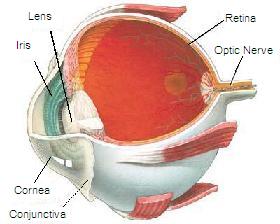Home > about eyes > Retinitis Pigmentosa
Retinitis Pigmentosa
Causes, incidence, and risk factors
Retinitis pigmentosa can run in families. The disorder can be caused by a number of genetic defects.
The cells controlling night vision (rods) are most likely to be affected. However, in some cases, retinal cone cells are damaged the most. The main sign of the disease is the presence of dark deposits in the retina.
The main risk factor is a family history of retinitis pigmentosa. It is an uncommon condition, making up only 5% of the membership of the Royal New Zealand Foundation for the Blind.
Symptoms
Symptoms often first appear in childhood, but severe vision problems do not usually develop until early adulthood.
-
Decreased vision at night or in low light
-
Loss of side (peripheral) vision, causing "tunnel vision"
-
Loss of central vision (in advanced cases)
 Normal Vision |
 Simulated Retinitis Pigmentosa |
Signs and tests
Tests to evaluate the retina:
-
Color vision
-
Examination of the retina by ophthalmoscopy after the pupils have been dilated
-
Fluorescein angiography
-
Intraocular pressure
-
Measurement of the electrical activity in the retina (electroretinogram)
-
Pupil reflex response
-
Refraction test
-
Retinal photography
-
Side vision test (visual field test)
-
Slit lamp examination
-
Visual acuity
Treatment
There is no effective treatment for this condition. Wearing sunglasses to protect the retina from ultraviolet light may help preserve vision.
Some studies have suggested that treatment with antioxidants (such as high doses of vitamin A palmitate) may slow the disease. However, taking high doses of vitamin A can cause serious liver problems. The benefit of treatment has to be weighed against risks to the liver.
Several clinical trials are in progress to investigate new treatments for retinitis pigmentosa, including the omega-3 fatty acid, DHA.
Microchip implants that go inside the retina and act like a microscopic video camera are in the early stages of development for treating blindness associated with this and other serious eye conditions.
It can help to see a low-vision specialist, who can help you adapt to vision loss. Make regular visits to an eye care specialist, who can detect cataracts or retinal swelling - both of which can be treated.
Expectations (prognosis)
The disorder will continue to progress, although slowly. Complete blindness is uncommon.
Complications
Peripheral and central loss of vision will eventually occur.
Patients with retinitis pigmentosa often develop cataracts at an early age, or swelling of the retina (macular edema). Cataracts can be removed if they contribute to vision loss.
Many other conditions have similarities to retinitis pigmentosa, including:
-
Friedreich's ataxia
-
Laurence-Moon syndrome (also called Laurence-Moon-Bardet-Biedl syndrome)
-
Mucopolysaccharidosis
-
Myotonic dystrophy
-
Usher syndrome (a combination of retinitis pigmentosa and hearing loss)
Calling your health care provider
Call us if night vision becomes difficult or if you develop other symptoms of this disorder.
Prevention
Genetic counseling and testing may help determine whether your children are at risk for this disease.
References
- Berson EL. Retinitis pigmentosa and allied retinal diseases. In: Tasman W, Jaeger EA, eds. Duane's Ophthalmology. 15th ed. Philadelphia, Pa: Lippincott Williams & Wilkins; 2009:chap 24.
- Fay A. Diseases of the visual system. In: Goldman L, Ausiello D, eds. Cecil Medicine. 23rd ed. Philadelphia, Pa: Saunders Elsevier;2007:chap 449.
- Sieving PA, Caruso RC. Retinitis pigmentosa and related disorders. In: Yanoff M, Duker JS, eds. Ophthalmology. 3rd ed. Maryland Heights, Mo: Mosby Elsevier;2008:chap 6.10.
- RNZFB statistics 30 June 2010.




